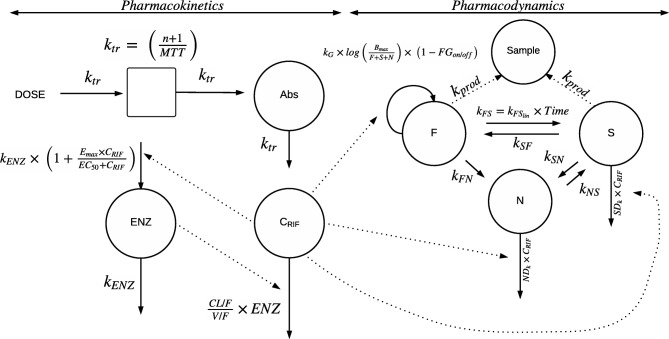Figure 1.

Schematic describing the final model. The dose (DOSE) is transferred from the absorption site (Abs) to the central compartment by a transit rate constant ktr, which is described by the number of compartments (n) +1 divided by the mean transit time (MTT). Drug is eliminated linearly as described by rifampicin oral clearance (CL/F) divided by the apparent volume of distribution (V/F), at the preinduced stage. The pharmacokinetic (PK) model includes an enzyme turnover model, in which plasma concentrations of rifampicin (CRIF) increase the rate constant for first‐order degradation of the enzyme pool (kENZ), which leads to an increase in the enzyme pool (ENZ) with an Emax model leading to increased elimination of rifampicin. The parameter EC50 is the rifampicin concentration (CRIF) at which half the Emax is reached. Emax is the maximal increase in the enzyme production rate. CRIF drives the effect implemented in the Multistate Tuberculosis Pharmacometric (MTP) model. The MTP model consists of three bacterial compartments; the fast‐multiplying state (F), the slow‐multiplying state (S), and the nonmultiplying state (N). Growth is present for F described by a fast‐multiplying bacterial growth rate (kG) multiplied by the natural logarithm of the system carrying capacity per milliliter sputum (Bmax) divided by the number of F, S, and N. F can transfer to N described by the transfer rate from fast‐ to nonmultiplying state (kFN). Transfer between F and S is described by a time‐dependent transfer rate from fast‐ to slow‐multiplying state (kFSlin). S can transfer to F and N described by the transfer rate from slow‐ to fast‐multiplying state (kSF) and transfer rate from slow‐ to nonmultiplying state (kSN), respectively. N can transfer to S described by the transfer rate from non‐ to slow‐multiplying state (kNS). Drug effect enters the model as fractional inhibition of growth of fast‐multiplying state (FGon/off) in presence of drug according to the PK model, as second‐order nonmultiplying death rate (NDk) and as second‐order slow‐multiplying death rate (SDk). The bacterial number of F and S together with the sputum production rate (kprod) describes the amount of bacteria that is present in the sputum sample compartment (Sample).
